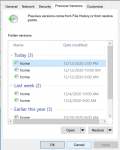So after running on FreeNAS 9.10.2-U6 for approximately the past 8 years, I decided to update to 11.3-U5 and TrueNAS 12. Everything seems to be working well, mostly the learning curve with the new GUI and how things are done. I like the updated GUI, it seems to do most things better.
Anyway, a MAJOR issue I ran into is that Windows' "Restore Previous Versions" is only partially randomly working.
At first, the previous versions didn't show up at all, but after a bunch of fiddling around, recreating new periodic snapshot tasks, deleting and recreating my SMB shares, cleaning up old snapshots (short of deleting them all. I have about a year's worth of snapshots, taken hourly, 5 days a week), letting snapshots be created and then setting up the SMB share, I was able to get some to show.
But it's now completely random what shows in Windows. The snapshots are being taken correctly in the TrueNAS GUI, but the ones that make it to "Restore Previous Versions" are random. I've also tried downgrading to 11.3-U5, same issue. Both show the snapshots randomly, although each version showed different individual snapshots on the same day (Like 11.3-U5 showed 6AM, 10AM, 2PM, 12.0 showed 7AM, 8AM, 10AM, 1PM, all from the same snapshots taken in the GUI). I've attached an example of the difference between the FreeNAS GUI and "Restore Previous Versions."
I haven't tried downgrading to 9.10.2 again, but I'm sure that will work normally as it did for so long. I really miss the option on the new GUI to be able to select which snapshot tasks are used for "Restore Previous Versions." I'm sure there was a reason they removed it, but I really need help here.
We use this feature often! We have thousands of customer folders in our main data folders and many people accessing them so there's all kinds of stupid things that happen. People dragging folders into other folders accidently, deleting folders if they disabled the delete confirmation, ransomware encrypting the entire folder, people editing files that others currently are working on or haven't been assigned to them, the list goes on. Too many times to count on how the feature has saved us and very quickly, open older version, copy/paste, done.
I've searched and searched and haven't found a way to get this working back the way it used to/should be. Any help would be greatly appreciated as we're down for the weekend, and I have until Sunday night to decide if I'm going all the way back to 9.10.2 which I have config backups for, but there are iSCSI shares and other things that won't just come over 1 to 1.
Ohh wise gurus of Free/TrueNAS, please show me the way! Thank you. Stay well and stay safe.
Anyway, a MAJOR issue I ran into is that Windows' "Restore Previous Versions" is only partially randomly working.
At first, the previous versions didn't show up at all, but after a bunch of fiddling around, recreating new periodic snapshot tasks, deleting and recreating my SMB shares, cleaning up old snapshots (short of deleting them all. I have about a year's worth of snapshots, taken hourly, 5 days a week), letting snapshots be created and then setting up the SMB share, I was able to get some to show.
But it's now completely random what shows in Windows. The snapshots are being taken correctly in the TrueNAS GUI, but the ones that make it to "Restore Previous Versions" are random. I've also tried downgrading to 11.3-U5, same issue. Both show the snapshots randomly, although each version showed different individual snapshots on the same day (Like 11.3-U5 showed 6AM, 10AM, 2PM, 12.0 showed 7AM, 8AM, 10AM, 1PM, all from the same snapshots taken in the GUI). I've attached an example of the difference between the FreeNAS GUI and "Restore Previous Versions."
I haven't tried downgrading to 9.10.2 again, but I'm sure that will work normally as it did for so long. I really miss the option on the new GUI to be able to select which snapshot tasks are used for "Restore Previous Versions." I'm sure there was a reason they removed it, but I really need help here.
We use this feature often! We have thousands of customer folders in our main data folders and many people accessing them so there's all kinds of stupid things that happen. People dragging folders into other folders accidently, deleting folders if they disabled the delete confirmation, ransomware encrypting the entire folder, people editing files that others currently are working on or haven't been assigned to them, the list goes on. Too many times to count on how the feature has saved us and very quickly, open older version, copy/paste, done.
I've searched and searched and haven't found a way to get this working back the way it used to/should be. Any help would be greatly appreciated as we're down for the weekend, and I have until Sunday night to decide if I'm going all the way back to 9.10.2 which I have config backups for, but there are iSCSI shares and other things that won't just come over 1 to 1.
Ohh wise gurus of Free/TrueNAS, please show me the way! Thank you. Stay well and stay safe.
Attachments
Last edited:


